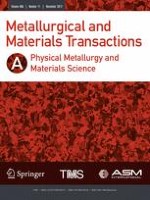One of the critical issues of CGI and SGI production is the control of nucleation and growth mechanisms of graphite.[
1] The nucleation of graphite is commonly assumed heterogeneous in main graphite nucleation theories.[
2] This concept assumes that graphite particles nucleate on a pre-existing inclusion in the liquid.[
3‐
7] In the case of lamellar graphite iron (LGI), these inclusions are complex sulfides (Mn,X)S that at the same time have nucleated on complex oxides of Al, Si, Zr, Mg, and Ti.[
3‐
5] On the other hand, graphite in SGI and CGI is observed to have similar nuclei, formed by complex Mg silicates (MgO.SiO
2) which are nucleated on the external layer of MgS and CaS sulfides.[
6] The subsequent growth of graphite nuclei is primarily affected by two factors: the presence of surface-active impurities in the melt, and the cooling rate during solidification of the alloy.[
1] The effect of the latter is widely accepted; higher cooling rates promote the formation of SGI. The influence of impurities can be divided into two categories: (a) reactive impurities leading towards a SGI transition such as Mg, Ce, Ca, Y, and La, called compacting or spheroidizing elements; and (b) surface-active impurities favoring lamellar graphite formation, such as S, O, Al, Ti, As, Bi, Te, Pb, and Sb, called anti-compacting or anti-spheroidizing elements.[
1] The presence of these impurities influences the predominant growth direction of graphite.[
8,
9] In the case of LGI, dominant growth occurs along the A-axis, while in SGI it happens along the C-axis. CGI is in an intermediate situation since dominant growth direction changes continuously between the A-axis and the C-axis.[
8,
9] The surface-active impurities are absorbed in the prismatic face of the hexagonal graphite lattice, creating a non-faceted interface, that requires low driving forces to grow,
i.e., low undercooling, like in the case of LGI, while for SGI the faceted interface requires larger undercooling to grow.[
2,
4,
7] Previous experiments show that a completely impurities-free melt would solidify as SGI, indicating that the preferential shape for graphite is spheroids in the total absence of active surface impurities.[
9] However, the amount of impurities needed to promote the formation of LGI is extremely low,[
2] being the presence of O and S the most detrimental to that effect due to their strong tendency to reduce the surface energy.[
1,
8,
9] The presence of dissolved oxygen in the melt has been shown to have a direct impact in the nodularity of the iron.[
10‐
12] The formation of CGI and SGI, therefore, requires the reduction of the amount of dissolved O and S that are regularly present in the materials used as base alloys. The practical way to achieve this reduction is by the addition of specific elements reacting and combining with O and S and hence cleaning the melt from these impurities, in a process called nodularization. The main element used for this purpose is Mg, even though some other elements like Ce or a RE mixture are also used with the same objective.[
2,
13,
14] Mg added to the melt, usually as FeSiMg, is used to combine most of the O dissolved in the melt by formation of oxides. The presence of dissolved S is also eliminated by Mg, producing MgS. High levels of S thus represent a complication for this purpose, since part of the Mg intended for O neutralization will be consumed by S making it a matter of great importance to have a close control on this process.[
12,
15] Residual Mg contents of 0.006 wt pct are reported as the lower limit to produce CGI, while the upper limit is around 0.01 wt pct residual Mg.[
2] To ensure a full spheroidization in SGI production, the measured residual Mg has to be between 0.02 and 0.06 Mg wt pct.[
14] These boundaries will change as a function of the amount of total impurities, shifting the CGI region towards higher Mg content in case of high presence of O and S. There are two main problems associated with the nodularization treatment in CGI and SGI production. The first one is to achieve the intended nodularity with the treatment at the end of the solidification. The region between LGI and CGI is especially complex, since there is an abrupt transition from CGI to LGI as a function of Mg content, complicating CGI production.[
13] In the case of SGI production, high additions of Mg are reported to attenuate the effect after a critical level, reaching an asymptotic level for nodularity.[
13] The second problem is the disappearance of the effect of this nodularization treatment over time. This occurs when the treated iron is held at elevated temperatures. The practical solution is therefore usually to minimize the time between nodularization treatment and pouring. Previous works have studied the fading phenomenon in SGI and CGI production, studying its relation to cooling curves and the residual Mg after different holding times.[
16‐
21] All these technological difficulties severely hamper laboratory investigations in CGI, and to some extent also in SGI, which in turn limits the understanding of complex problems occurring during their solidification that often lead to defect formation. The present work, therefore, reports an accurate and reliable experimental technique, which enables controlled laboratory-scale production of cast irons, with controlled graphite morphology ranging from SGI to LGI. A re-melting experimental procedure has been designed to control the process of solidification of a base SGI material and adjust its final nodularity by controlling the holding time as the experimental variable. Tools to evaluate the nodularity and the Mg fading process during the reversion process of SGI are presented, including empirical equations to predict the resulting nodularity at the end of the solidification process for both SGI and CGI production regions.
